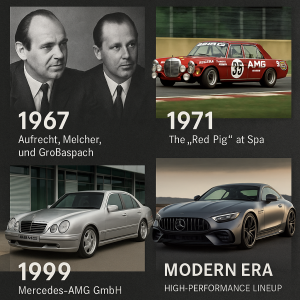When you see the AMG badge on a Mercedes-Benz, you’re looking at more than just a performance upgrade—you’re witnessing a legacy. AMG history is the result of decades of racing passion, engineering precision, and relentless pursuit of speed.
Let’s take a drive through the fascinating history of Mercedes-AMG, from its humble roots to becoming one of the world’s most respected performance brands.
1967: The Birth of AMG
It all began in Burgstall, Germany, where two former Mercedes engineers, Hans Werner Aufrecht and Erhard Melcher, launched a small tuning company focused on building race engines for Mercedes vehicles.
The name AMG comes from:
- Aufrecht (Hans Werner Aufrecht)
- Melcher (Erhard Melcher)
- Großaspach (Aufrecht’s birthplace)
Their mission? Build faster, stronger, race-ready machines.
1971: First Taste of Glory

In 1971, AMG made headlines when their heavily modified Mercedes 300 SEL 6.8 AMG won its class and finished 2nd overall at the 24 Hours of Spa. The car was nicknamed the “Red Pig”, and it shocked the racing world.
From that moment, AMG earned global recognition as a force in motorsport and performance tuning.
1980s–1990s: The Rise of the Street-Legal AMG
Throughout the ’80s and ’90s, AMG began creating limited-run, high-performance versions of Mercedes-Benz sedans, including:
- AMG Hammer – A brutal V8-powered E-Class coupe that embarrassed Ferraris.
- E 60 AMG – One of the first sedans to blend extreme speed with luxury.
- C 36 AMG (1993) – The first AMG model to be jointly developed with Mercedes-Benz.
This period marked AMG’s shift from small tuner to official brand partner.
1999: AMG Joins the Mercedes Family
In 1999, Daimler AG (Mercedes’ parent company) bought a controlling interest in AMG, forming Mercedes-AMG GmbH. This move allowed AMG models to be developed directly from the factory—no longer just tuned after production.
From here, AMG models exploded in popularity.
Modern Era: The AMG We Know Today
Today, AMG is synonymous with high-performance luxury. Their model range includes:
- A 45 S AMG – A compact hatch with 416 HP
- C 63 S E Performance – Hybrid muscle with F1 tech
- G 63 AMG – A luxury tank with a hand-built twin-turbo V8
- GT Series – Purpose-built performance coupes and track weapons
Each AMG engine is still built by hand, and bears the signature of the engineer who assembled it—carrying on the “One Man, One Engine” philosophy.
️ AMG in Motorsport
Mercedes-AMG plays a key role in Formula 1, as both:
- The performance team behind Mercedes-AMG Petronas F1
- The supplier of official F1 safety cars and medical vehicles
This racing connection influences the development of AMG street cars—especially in aerodynamics, hybrid systems, and driving dynamics.
The Future of AMG
With the rise of electrification, AMG is evolving with it:
- AMG EQ models (like the EQE 53 AMG) offer instant torque and power
- Hybrid tech like in the C 63 S E Performance brings F1 technology to the street
- AMG is working on retaining emotion and soul even in electric platforms
Final Thoughts
From a garage in Germany to the world’s racetracks
You also like: Top 7 AMG Features That Make it Truly Unique
